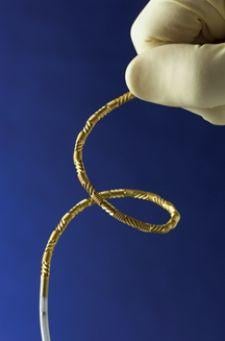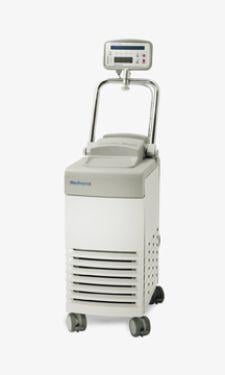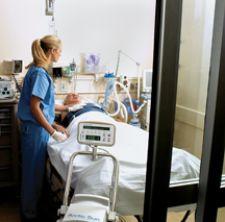
The Celsius Control System's heat transfer catheter has a built-in, flexible temperature control element.
Ice packs and cold compresses have been used for centuries to reduce swelling and fevers. But it’s only been within the last five years that clinicians have witnessed the dramatic results — especially in patients who have suffered a cardiac arrest — that can be achieved through induced hypothermia.
The concept is simple: If a patient’s core body temperature is lowered and maintained at a low level for a period of time, the body’s metabolic rate slows down. In the case of a cardiac arrest, this reduces the brain’s need for oxygen thus preventing, or drastically reducing, brain damage while increasing the patient’s overall chances for survival.
Interestingly, most critical care-oriented organizations such as the American Association of Critical Care Nurses (ACCN) and the Society of Critical Care Medicine (SCCM) have not developed specific guidelines on induced hypothermia.
The Association of periOperative Registered Nurses (AORN), for example, has in place a policy for cooling patients suffering from malignant hyperthermia — a fever that some surgical patients develop after being anesthetized, says Joan Blanchard, R.N., a nursing specialist in the Association’s Center for Nursing Practice. In these cases, the administration of Dantrolene and the application of ice packs will drop the patient’s temperature down to a targeted 100.4 F.
Plus, she added, “The other things you keep available in the recovery room are plenty of ice and special canvas stretchers on which a patient is placed when you pack him with the ice.”
Yet, when it comes to therapeutic hypothermia in cases of cardiac arrest, these major organizations defer to the guidelines established by the International Liaison Committee on Resuscitation (ILCOR) and the American Heart Association.
The ILCOR made its recommendations in October 2002, shortly after the results of two randomized clinical studies — one in Europe and the other in Australia — were published in the New England Journal of Medicine.
The ILCOR recommends: 1.) Unconscious adult patients with spontaneous circulation after out-of-hospital cardiac arrest should be cooled to 32°C to 34°C for 12 to 24 hours when the initial rhythm was ventricular fibrillation; and 2.) Such cooling may also be beneficial for other rhythms or in-hospital cardiac arrest.
In 2005, the American Heart Association (AHA) adopted the ILCOR recommendations as Class II guidelines but stopped short of recommending them as a therapy for other cardiac-related problems, saying further research was needed.
But the reality is that the popularity of induced hypothermia is growing and is often applied in cases of acute myocardial infarction, post-cardiac arrest, acute ischemic stroke and cerebral aneurysm.
Back from the brink
In December 2005, a man who would otherwise have been pronounced brain dead was brought back to life through induced hypothermia, thrusting Joseph Varon, M.D. into the limelight.
A professor of Medicine at the University of Texas Health Sciences Center School of Medicine in Houston and a clinical professor of Medicine at the University of Texas Medical Branch in Galveston, Dr. Varon also is on staff at St. Luke’s Episcopal Hospital in Houston.
Dan O’Reilly was airlifted to St. Luke’s after nearly drowning while swimming in the Pacific Ocean off Ixtapa, Mexico. Underwater and without oxygen for 45 minutes, O’Reilly was intubated by rescue workers and flown to Houston. On a respirator but in a comatose state, there was little hope. “That guy was dead for three hours and they did CPR on him for 30 to 40 minutes,” Dr. Varon said. “I got him 12 hours after the fact.”
But Dr. Varon wrapped him in a cooling blanket and brought his body temperature down to 90°F while keeping him on life support. After three days, O’Reilly awakened.
Dr. Varon says years of interest in resuscitation led him to induced hypothermia. “I was involved in a few trials and saw the benefits,” he said. “When you decrease the metabolic rate of the body, it allows the body to heal.”
Since treating the drowning victim, Dr. Varon says the number of times he’s used therapeutic hypothermia is “too many to count.” And while not every case has been as dramatic, he said, “I’ve revived many who were clinically dead.”
Surface or endovascular cooling?
As a true believer in the benefits of induced hypothermia, Dr. Varon says he uses both generally accepted methods of cooling: surface cooling, which includes the use of cooling blankets or vests; and endovascular (intravascular) cooling, which uses a catheter and circulating cold saline to cool the blood.
Yet, some physicians have strong preferences for one method over the other.
“We use temperature control and temperature management every day, but a couple of times a month we’ll push patients — mainly those suffering from cardiac arrest, ischemic stroke or intercerebral hemorrhage — down to 32°C,” said Michael DeGeorgia, M.D., head of the Neurological Intensive Care Program and director of the Neurology/Intensive Care Unit at The Cleveland Clinic.
Dr. DeGeorgia had been using a catheter system for intravascular cooling, but said he has since switched to surface cooling.
Although he acknowledges that intravascular cooling is more precise and can lower a patient’s core temperature to the desired range within 10 to 15 minutes, he said the major drawback is that it’s an invasive procedure requiring a catheter to be placed in a major vessel such as the inferior vena cava. Not only is there a greater risk of infection, but there’s also a greater chance that bleeding can occur or that a clot will form in the leg, he said.
“For most patients, surface cooling works pretty well,” he noted. “It’s not as quick as a catheter, but it’s easy to use.”
To achieve the desired results through surface cooling, Dr. DeGeorgia uses the Arctic Sun Therapeutic Temperature Management System from Louisville, CO-based Medivance Inc.
A water-based system, Arctic Sun uses hydrogel-coated energy transfer pads that can adhere to the patient’s abdomen, back and thighs. The system pulls water under negative pressure through the pads at a high velocity in a temperature range between 4°C and 42°C for rapid heat exchange.
The system also features a control module with a built-in control algorithm that reacts to patient temperature by automatically adjusting the circulating pad water temperature to achieve a preset patient target temperature. The temperature feedback from the patient is supplied to the control module using standard YSI-400 patient temperature probes, such as bladder, rectal, esophageal or nasopharyngeal probes.
Since maintaining an optimal temperature range is crucial during both the cooling and rewarming process, the system incorporates a “time-to-target” feature that facilitates rewarming. Once the target temperature is set and the rate of rewarming is programmed in a range of 0.05°C to 0.5°C per hour, the patient is gradually and accurately rewarmed over the preset period of time.
Extreme caution must be taken during the rewarming process to prevent further injury to the brain, Dr. DeGeorgia says. “The brain doesn’t like getting rapidly rewarmed. That causes rebound edema.”
Temperature management during the initial stages of cooling also is crucial. Since shivering can raise the body’s metabolic rate, Dr. DeGeorgia says patients are intubated and given a neuromuscular block to prevent shivering.
Most patients are cooled for the recommended 24 hours, but Dr. DeGeorgia said, “If you start cooling right away, you can probably get away with only six to eight hours.” Brain edema patients, however, are usually cooled for “a couple of days or until the swelling goes down,” he said.
Another proponent of surface cooling is David Greer, M.D., assistant professor of Neurology at Harvard Medical School and the associate residency program director at Massachusetts General Hospital.
He first used therapeutic hypothermia in 2002 on a female patient who had suffered cardiac arrest and went into a coma. Instead of ice packs and a cooling blanket, he now uses the Arctic Sun system — about two to four times a month — to induce hypothermia in patients.
Although patients undergoing induced hypothermia are cared for in the critical care unit, Dr. Greer is adamant about early intervention. “The faster you start it, the better it works. Optimally, it’s begun in the ER.”
Robert Silbergleit, M.D., agrees. As an associate professor of Emergency Medicine at the University of Michigan at Ann Arbor and a practicing ER physician, Dr. Silbergleit says cooling a patient after a cardiac arrest should start within the first hour, and for this Dr. Silbergleit relies on endovascular cooling.
“We experimented with surface cooling, but there was no feedback control and it was more work for the nurses,” he said.
After comparing products from leading manufacturers, Dr. Silbergleit chose the Celsius Control System from San Diego, CA-based InnerCool Therapies Inc., a subsidiary of Cardium Therapeutics.
Using proprietary technology, the system consists of a disposable heat transfer catheter that has a built-in, flexible temperature control element (TCE); an administration cassette that maintains the sterility of the saline conduit; and a console for automating the cooling and rewarming process. In addition, this system’s TCE does not expand inside the body, so the outer diameter of the TCE remains constant throughout the cooling and rewarming process, unlike those in balloon-based systems that expand during use.
Average cool-down rates are between 5.0°C - 6.0°C per hour and average rewarm rates are between 2.0°C - 3.0°C per hour.
Since purchasing the system in September 2006, Dr. Silbergleit says he’s induced hypothermia in 12 patients. None developed catheter-related complications and 70 percent survived, he said. The nationwide average rate of survival at discharge for comatose patients after a cardiac arrest is only 25 percent, he notes.
Obstacles to overcome
Although the use of induced hypothermia is growing, especially among large academic medical centers, wide-spread acceptance may still be a long way off. “Only 13 percent of hospitals in the U.S. use some kind of hypothermia,” said Dr. Varon, compared to 50 percent in Europe.
There are reimbursement obstacles to overcome, and Dr. Silbergleit says there is also the question as to which department should oversee the procedure. “It’s a turf issue, but nobody really owns this problem. Some in emergency medicine think it’s a critical care problem. Some in critical care think it’s an emergency medicine problem.”
Compounding the debate is the fact that induced hypothermia should be started shortly after a patient goes into cardiac arrest. Ideally, cooling should begin “in the field while they’re on the way to the hospital,” said Dr. DeGeorgia.
But Dr. Greer points out that, for example, there are 17 different ambulance companies operating in the Boston area alone. Getting them all to adopt a single policy would present a very real logistical problem.





